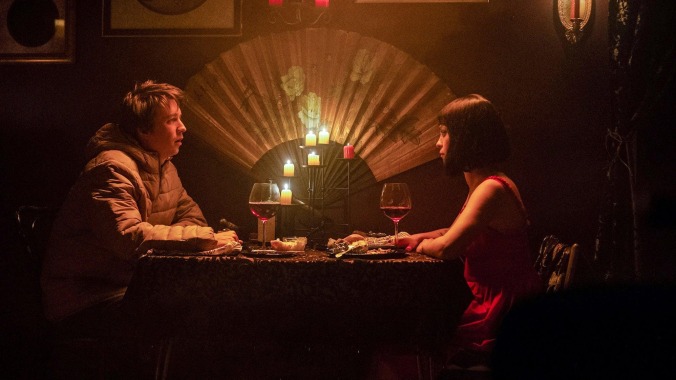Chariot aspires to Lynchian surrealism, but falls short
Thomas Mann and Rosa Salzar try to make sense of recurring dreams and neighborly romances while John Malkovich holds court in cartoonish wigs
Film Reviews Chariot
Chariot opens in a rustic cabin in 1840, where an old cowboy coughs blood into his hands, the movies’ universal signal that he’s going to die. From his porch, he monitors strange lights that resemble a modern weather station. But before he can explore the landscape further, a plague doctor in a creepy mask suddenly shows up, the movie’s title appears, and the cowboy disappears, never to return. Which is a shame, because his short, largely dialogue-free scene doesn’t just feature the best location and cinematography in the movie, but its most efficiently edited storytelling as well. Excitingly, the hotel-room finale of Kubrick’s 2001 feels like an inspiration.
If only it related meaningfully to the rest of writer-director Adam Sigal’s movie. Or maybe it does, and the connection is simply too subtle and weird. Yes, what the cowboy sees becomes important later, but why it shows up in 1840 never does. The rest of the story occurs in the present day, focusing on the hilariously named Harrison Hardy (Thomas Mann), a young man who experiences a recurring dream. It is “extremely mundane,” according to Dr. Karn, played by John Malkovich with buck teeth and a red fright wig that looks like it was left over from Woody Harrelson’s post-credits scene in the original Venom. Karn seems to style it slightly differently each time we see him, including with a Hello Kitty-style bow at one point. He’d fit in well as the villain in one of Joel Schumacher’s Batman sequels.
When not cataloguing Malkovich’s hair styles, Harrison hangs out at his weird new apartment building, the Lafayette, which is populated by some real oddballs, including a man who levitates (Henry Penzi), a masked female singer (Torii Wolf), an endangered tortoise wrangler (Vernon Davis), and a Hollywood assistant (Scout Taylor-Compton) who occasionally lapses into the personality of a middle-aged “Englishman,” complete with an atrocious fake accent. Most significant, though, is Maria (Rosa Salazar), who’s immediately drawn to Harrison. Maria is too edgy to fall into the manic pixie dream girl stereotype, and Salazar makes her appealing in a way that a character like Harrison would want to romance her, but justifiably be intimidated by at the same time.
Sigal describes his love for David Lynch at length in the press kit, and it’s clear he’s aspiring here to make his own Mulholland Drive or Inland Empire. But he doesn’t possess enough of Lynch’s intuitive surrealism to pull it off, and technically speaking, could stand to use more subdued lighting if he really wants to imbue his sets with the creeping dread of his hero’s work. One scene comes close to nailing it, the aforementioned moment with Malkovich and his hair bow, which also involves a doppelganger freakout with a studio executive played by Shane West where unsettling sound design and a disorienting sequence of events mesh together nicely. But like with the cowboy scene at the beginning, Sigal seems content for it to serve an immediate purpose, whatever that is, and then move on.
Many of Chariot’s plot points could easily be cleared up if any of the characters had a smartphone, but Sigal commits an unforced error by deciding late in the film that Harrison actually has one but evidently hasn’t been using it. Evidently keeping count of the number of times he’s had the same dream made him forget how to use a ubiquitous communications device for anything other than receiving calls.
Ultimately, Chariot certainly doesn’t lack ambition, just execution. From the cast to its odd, intriguing locations, Sigal was successful in assembling many of the right ingredients. Unfortunately, they lack a chef who knows how to properly combine them, whether that’s to create a meaningful sense of cohesion or to truly create the kind of beautiful chaos that makes Lynch such a mesmerizing source of inspiration.
1 Comment
“Rosa Salzar”?